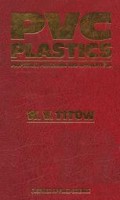Abstract
Injection moulding is one of the most important melt processes for thermoplastics. With PVC, and especially uPVC, its operation is complicated by two factors: the susceptibility of PVC polymers to heat degradation, and their high melt viscosity. These factors can give rise to problems: they necessitate particularly careful control of the thermal input, melt temperature, and pressures in the process. However, in recent years the difficulties have been considerably eased by the development of effective, sophisticated electronic means of process control, and by the advent of ‘easy flow’ uPVC moulding compounds.
Access this chapter
Tax calculation will be finalised at checkout
Purchases are for personal use only
Preview
Unable to display preview. Download preview PDF.
References
Turner, L. W. In PVC Technology, 4th edn, W. V. Titow. Elsevier Applied Science Publishers, London and New York, 1984, Ch. 15.
Glenn, W. B., Plast. Technol., 26(10) (1980) 73–75.
Menges, G., Schmidt, T. & Potsch, G., Mod. Plast. Int., 17(9) (1987) 68–71.
Johannaber, F., Injection Moulding Machines—A Users Guide. Carl Hanser Verlag, Munich, 1983.
Anon., The Principles of Injection Moulding. ICI Technical Service Note G 103 (2nd edn), ICI Plastics Division, England.
Stökhert, K. (Ed.), Mould Making Handbook. Carl Hanser Verlag, Munich, 1983.
Menges, G. & Mohren, P., How to Make Injection Moulds. Carl Hanser Verlag, Munich, 1986.
Pye, R. G. W., Injection Mould Design, George Goodwin Ltd/PRI, London, 1982.
Tulley, F. T. & Harris, B. C. In Encyclopedia of PVC, ed. L. I. Nass. Marcel Dekker, New York, 1979, Ch. 24, p. 1313.
Huber, M., Plast. Rubb. Wkly (18 Feb, 1977) 20-23.
Anon., Technical Bulletins 8/73. Ethyl Corporation, Polymer Division, Baton Rouge, LA, USA.
Ganzeman, A. J., Plast. Rubb. Process. Applns, 4(2) (1984) 127–133.
Whelan, A., Brit Plast. Rubb., (Apr. 1981) 25.
Murrey, J. L. & Dito, A. L., Plast. Technol., 27(12) (1981) 79–82.
Worbye, J., Polym. Plast. Technol. Engng, 25 (1986) 109–126.
Anon., Recommended Molding and Processing Temperatures of Plastics and Rubbers. Regloplas AG, Flurhofstrasse 158, CH-9006 St Gallen, Switzerland.
Brown, J., Injection Moulding of Plastic Components—A Guide to Efficiency, Fault Diagnosis and Cure. McGraw-Hill Book Co., London, 1979.
Haworth, B., Sandilands, G. J. & White, J. R., Plast. Rubb. Int., 5(3) (1980) 109–113.
Gilbert, M., Marshall, D. E., Voyvoda, J. C. & Copsey, C. J., Plast. Rubb. Process., 3 (1979) 96.
Rights and permissions
Copyright information
© 1990 Elsevier Science Publishers Ltd
About this chapter
Cite this chapter
Titow, W.V. (1990). Injection Moulding. In: PVC Plastics. Springer, Dordrecht. https://doi.org/10.1007/978-94-011-3834-5_16
Download citation
DOI: https://doi.org/10.1007/978-94-011-3834-5_16
Publisher Name: Springer, Dordrecht
Print ISBN: 978-1-85166-471-9
Online ISBN: 978-94-011-3834-5
eBook Packages: Springer Book Archive

